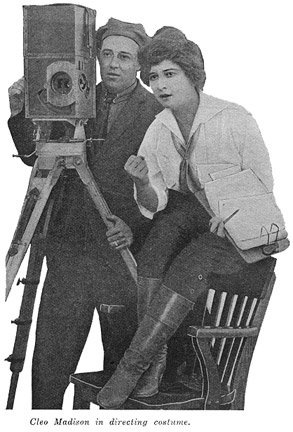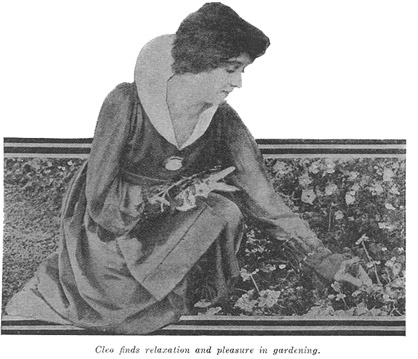
An archive of articles on the silent era of world cinema.
Copyright © 1999-2025 by Carl Bennett and the Silent Era Company.
All Rights Reserved.
|
|
The Dual Personality of An Actress
ANY position which a man has occupied in moving pictures has been and is now occupied by a woman. There are even women “cameraman.” In the field of direction, women take an important place. There are not as many directresses as directors, but in reputation and accomplishment they stand just as high.
 Cleo Madison’s name occurs to every one when women directors are mentioned. This versatile and beautiful actress has occupied the dual positions of star and director for some time, and filled both with honor. She came into prominence, as every one knows, through her daring and convincing work in the Universal serial, “Trey o’ Hearts.” She is a student and close observer, and had been in pictures only a short time when she began to extend her interest beyond the day’s work and toward the producing and the mechanical side of the profession. She made a special study of the camera itself, and she is one of the few directors who is able, if necessary, to film her own productions. Cleo Madison’s name occurs to every one when women directors are mentioned. This versatile and beautiful actress has occupied the dual positions of star and director for some time, and filled both with honor. She came into prominence, as every one knows, through her daring and convincing work in the Universal serial, “Trey o’ Hearts.” She is a student and close observer, and had been in pictures only a short time when she began to extend her interest beyond the day’s work and toward the producing and the mechanical side of the profession. She made a special study of the camera itself, and she is one of the few directors who is able, if necessary, to film her own productions.
When her opportunity to direct came she was ready for it. The experience was not altogether new to her, for she had been her own stage manager in the company known as “The Cleo Madison Stock Company,” which had presented a large repertoire of modern plays. She grasped eagerly the opportunity to try out some of the theories of photoplay production which she had been accumulating during her experience as a screen actress.
“Every play in which women appear needs the feminine touch,” she declared upon taking up her new duties. “Lois Weber’s productions are phenomenally successful, partly because her woman creations are true to the spirit of womanhood. I believe in doing most of the work before the camera is called into action. It should never be necessary, except in the case of accident, to retake a scene. Every actor should have all opportunity to read the whole play from start to finish before playing his bit. How can you interpret a role unless you know its relation to the whole drama? If anyone is in ignorance of the story, the production always suffers. Once the filming of the scene is begun, nothing should hinder its completion. All the preparation for it should be thoroughly supervised beforehand.”
It was on this principle that Miss Madison produced many one and two reelers and the two five-reel features that stand to her credit during her experience as a director. For she is voluntarily resigning that position, in order to give her whole attention to the portrayal of one of the great heroines of the theatrical world, La Tosca. The screen version of the story of this famous character, conceived by Victorien Sardou for Sara [sic] Bernhardt, who created the role in the heyday of her beauty, will be eagerly awaited by all those familiar with the drama and with the musical version of Puccini, which is one of the favorite operas of the modern school and associated with the names of Mary Garden, Geraldine Farrar, Emmy Destinn and Olive Fremsted. The role is one which Miss Madison, whose greatest joy is, as she says herself, “the portrayal of the human emotions of joy and grief,” has long wished to try. She feels that she must concentrate all her powers on the interpretation of this great part, so she has resigned the reins of direction in favor of Rex Ingram, who is already known for his splendid work in the Mersereau pictures, “The Great Problem” and “Broken Fetters.” The photo adaptation will be based upon the opera rather than the play, and there will be a wealth of detail and “atmosphere” seldom equalled.
Miss Madison might be called the woman of dual personality, for two sides of her character seem to be developed in equal measure, and she finds herself alternately in the grasp of each of them. She is both a professional woman and a domestic one and it is impossible for her to decide at times, which is the real taste and which the cultivated one. She is the type of person who does whatsoever her hand finds to do with her might, and while she is in the grasp of one personality she entirely forgets the other. Her screen side is familiar to her public. Her thousands of admirers know her for a beautiful woman, who dresses with originality and distinction, who is absolute master of her emotions, and can portray the deepest human passions with an intensity which makes her acting seem like a page of life itself. Those who remember “Trey o’ Hearts” know that she possesses personal courage in a high degree, for the risks she took in the that hair-raising serial entitle her to rank among the dare-devils of the screen. She created a reputation for herself as a director as soon as the first picture with which the Universal entrusted her was released. The artistry of her sets is recognized, and in “Her Bitter Cup,” one of the first of the Red Feather features, she accomplished results of staging and lighting which set something of a standard for future productions. The public is not so well acquainted with her other self, but her friends insist that they alone know the real Cleo. She lives in one of the most charming bungalows in Hollywood with her mother and a little invalid sister, to whom she is devoted and for whom she makes her home as beautiful and attractive as a home can be. She is an ardent gardener, partly for the pleasure it gives her to make two blades of grass grow where one grew before, and partly for the added interest which her flowers bring to the shut-in life of her little companion. The first days of spring find Cleo Madison, the homemaker, in her garden, planning new decorations for the flower beds and watching for the re-appearance of her bulbs. She has a famous Dutch garden, which contains some of the finest specimens of bulbs to be found in this country, which were sent to Miss Madison by some of her admirers in Holland, the land of the tulip.
 Her gardening over for the day, Miss Madison visits her chicken farm, for she is a poultry expert as well. Some one presented her with a queer gift one day — five white hens. They seemed so much at home in their new surroundings, and Helen, the little sister, derived so much pleasure from watching them, that the actress decided to keep them and order a dozen more. With her usual thoroughness, she read up on the subject and found out just what chickens need in order to keep them happy and contented and insure a plentiful supply of eggs, and she was so pleased with her results that she declares her intention of going in seriously, some day, for poultry farming on a large scale. Her gardening over for the day, Miss Madison visits her chicken farm, for she is a poultry expert as well. Some one presented her with a queer gift one day — five white hens. They seemed so much at home in their new surroundings, and Helen, the little sister, derived so much pleasure from watching them, that the actress decided to keep them and order a dozen more. With her usual thoroughness, she read up on the subject and found out just what chickens need in order to keep them happy and contented and insure a plentiful supply of eggs, and she was so pleased with her results that she declares her intention of going in seriously, some day, for poultry farming on a large scale.
Another of Miss Madison’s accomplishments, when she is under the influence of her domestic personality, is cooking. She is a famous cuisiniere, and she enjoys nothing more than donning a big apron and setting to work to cook a real old-fashioned chicken dinner. Do you think that La Tosca knew very much about cocoanut icing? But, on the other hand, cooking seems just as uncongenial to a woman who has fought for her life on the edge of a cliff, who has climbed down between two freight cars and uncoupled them while the train was going at full speed, or performed any of the other little stunts which Cleo Madison undertook as all in the day’s work during the filming of the serial. Just the other day, in one of her own pictures, she was dragged at the tail of a wagon along a dusty road. But she performs all these things while the professional Cleo is holding sway, for the domestic Cleo professed frankly during the interview that she is not happy on top of the kitchen ladder.
The connecting link between the two Cleos seems to be a love of artistic clothes. This characteristic persists no matter which personality seems to be in possession of her. She designs her most successful gowns herself, and they are wonderfully well adapted to her style of large-eyed, rather wistful beauty. She is planning something “extra special” for the Tosca production, and rejoices that the lack of the cares of direction will enable her to put more time into the costuming of her role of the Italian singer. This article originally appeared in Moving Picture Stories, July 28, 1916, Volume VIII, Number 187, pages 28-29.
|




































